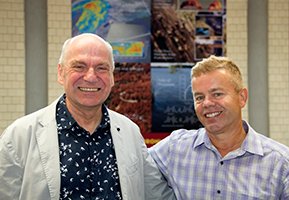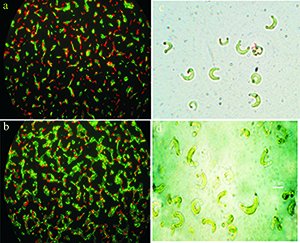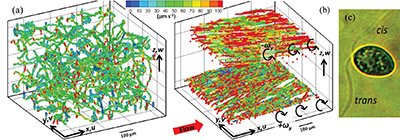Record Professors Vaughan Voller and Miki Hondzo

These water and the environment researchers enjoy a fruitful collaboration that started with a project (sponsored by the Legislative and Citizens Commission on Minnesota Resources) aimed at developing a barrier for carp. Hondzo specializes in biological flows, Voller in modeling. Further collaboration with Peter Sorensen (Fisheries, Wildlife, and Conservation Biology) and Dan Zielinski (Ph.D. 2013) established bench-mark studies on the effectiveness of sound-based fish deterrent systems. In addition, Voller and Hondzo currently co-advise Ph.D. student Jacqueline Taylor who is developing models to understand and predict harmful algal blooms in lakes.
Their long-term collaborative work is a great example of the synergistic interdisciplinary research within the Department of Civil, Environmental, and Geo- Engineering. Together, Hondzo and Voller are advancing our ability to manage and protect water environments in Minnesota and around the world.
PROFESSOR VAUGHAN VOLLER
Professor Vaughan Voller is driven to understand the impact of natural processes and to render complex environmental phenomena in a way that allows for direct and meaningful interpretation. He is particularly interested in developing methodologies to create computational and mathematical models of processes that involve the flow (movement) of fluid, mass, or heat. Voller has applied these methodologies across a wide spectrum of problems in the areas of civil, environmental, and geo- engineering. Voller’s main contributions involve modeling natural processes with a moving or free boundary, for example, locating the elevation and position of a water table or tracking the front between a melting solid and its liquid phase.
Starting with his Ph.D. work under Professor Mark Cross in the United Kingdom and post-doctoral research with Ken Reid (UMN), Voller developed algorithms and solutions for modeling solid/ liquid phase changes. These efforts and collaborations with former Ph.D. students Allon Brent (Ph.D. 1989) and Swami Swaminathan (Ph.D. 1994) resulted in development of the “enthalpy-porosity” method, now a method of choice for computational fluid dynamics software packages. Figure 1 shows an application of the enthalpy-porosity methodology, a computation of a solid crystal growing in an undercooled melt. The initial solid seed (far left) is warmer than the surrounding melt. The solid growth is controlled by the “leaking” of heat from the solid into the liquid, leading to an unstable dendritic growth. The evolving shape of the solid crystal is controlled by the curvature dependent surface tension.

One advantage of being on the faculty at UMN, one of the world’s leading research universities, is the opportunity to leverage research efforts through collaborations. A significant example is Voller’s continuing work directed at understanding and modeling the formation of river-mouth delta deposits and fluvial sedimentary fans. This work began when Earth Science Ph.D. student John Swenson (now Earth & Env Sci faculty at UMD) recognized how the phase change tracking algorithms developed by Voller’s group could be applied to the formation of sedimentary deltas. That initial spark (with input from Professor Chris Paola, Earth Sciences) opened a new avenue for understanding the dynamics of shorelines and resilient costal habitation. Man Liang (Ph.D. 2012) wrote her thesis centered on modeling channel and deposit dynamics of a growing sedimentary delta (Figure 2). The model captures key physics in the growth of a delta, in particular, the movement (avulsion) of surface channels and the mechanism of advancing the shoreline through a sequenced deposition of lobes.

Voller’s current efforts draw extensively from his early work on modeling phase transitions. His particular interest is modeling anomalous transport, which occurs when the transport behavior of a given quantity (for example, a contaminant) differs from behavior predicted by “textbook” models (for example, Fickian diffusion). “We like to think of our environment as a stable, well-controlled, linear world. We need to realize, however, that the natural world is an unstable, non-linear place where events in a particular time and location depend on history and conditions elsewhere as much as they do on local conditions,” Voller explains. Voller’s on-going research is focused on understanding how, where, and when history-dependent and nonlocal transport processes and phenomena arise in natural systems. Non-local phenomena occur during transport through systems that contain heterogeneity distributed over multiple length scales, through regions with varying properties like the Earth’s porous sub-surface. Voller believes a full understanding of anomalous transport is essential to better understand and control environmental clean ups. Voller and his collaborators, Fabio Aarão Reis (Federal University of Fluminense, Brazil), Diogo Bolster (University of Notre Dame), and Kimberly Hill (CEGE), developed models (Figure 3) that illustrate and explain anomalous transport behaviors.

PROFESSOR MIKI HONDZO
Professor Miki Hondzo’s long term goal has been to understand how moving fluids affect biochemical processes in lakes, wetlands, streams, and watersheds. At St. Anthony Falls Laboratory (SAFL), his group quantifies interactions of freshwater aquatic organisms and moving water. Microscopic algae and bacteria provide the foundation for functionality and health in the aquatic ecosystems that Hondzo studies. Hondzo’s research addresses issues of global importance: availability of clean water, restoration of degraded ecosystems, and production of renewable energy.
Clean water and ecosystem restoration
Three discoveries from Hondzo’s work impact treatments for drinking water and wastewater, farm practices that result in excessive nitrogen concentrations in aquatic ecosystems, and restorations of streams, lakes, and wetlands. Hondzo’s team discovered that smallscale turbulence mediates algal and bacterial physiology, finding a near twofold increase in growth rate for turbulence conditions commonly reported in lakes, wetlands, and rivers (Figure 4).

They also discovered that specific physical conditions trigger enhanced physiology of denitrifying bacteria and create small areas of active nitrate removal, which frequently account for a great percentage of nitrate removal in aquatic ecosystems.
A third discovery relates to scaling analysis, which scales up laboratory measurements of fluid flow and organisms’ physiology to field conditions. Microorganisms respond to moving fluids and turbulence in species-specific ways. However, Hondzo’s research has provided a mechanistic approach for analyzing the physiology of organisms and their nutrient uptake in naturally occurring moving fluids (Figure 5).

Laboratory findings verified by field measurements enabled Hondzo to develop predictive models of the physiology and spatial distribution of micro-organisms and nutrients in aquatic ecosystems. These predictive models are based on the fundamental scaling of turbulent flows in aquatic environments applied for the first time to the physiology and nutrient uptake of a variety of organisms.
Sustainable energy production
Microalgae is now being explored as a source for sustainable energy production. The concept is challenging and requires understanding of the physics, physiology, and metabolisms of algae. Hondzo’s research group has been active in interdisciplinary research evaluating the use of microscopic algae for biofuel production. The major costs in the production of biofuels by microscopic algae are external energy requirements for bioreactor operation and the separation of microalgae cells for lipid extraction.
Hondzo’s research has identified a quantitative link between microalgae swimming characteristics and concentration of lipids that gives a solid basis for optimizing the operation of bioreactors. Hondzo’s team also discovered how local fluid flow velocity gradients direct collective aggregation of microalgae in bioreactors (Figure 6). These findings could provide a pathway to a cost-effective technology for harvesting microalgae cells from dilute suspensions in bioreactors.

Water quality and sustainable energy are being studied by environmental engineers and governmental planners and regulators. Problems that affect society require understanding interactions among fluid flow, biological, and chemical transport. Hondzo believes it is important to teach these processes to engineers and scientists and that experiments are essential to gaining this understanding. So he developed curricula that integrate classroom-, laboratory-, and field-based learning for undergraduate and graduate level students.
Hondzo’s career focuses on interdisciplinary research between engineering and biological sciences and has resulted in numerous collaborations at the University of Minnesota.
RECORD PROFESSORSHIPS were made possible thanks to a generous donation by Dorothy Record Bauman, who left a gift through her estate that created the James L. Record Fund for the benefit of our department. Over more than forty years, the Record Fund has supported the research and teaching of CEGE faculty. Past Record Professors include Roberto Ballarini, Fotis Sotiropoulos, Heinz Stefan, Theodore Galambos, and Lawrence Goodman.